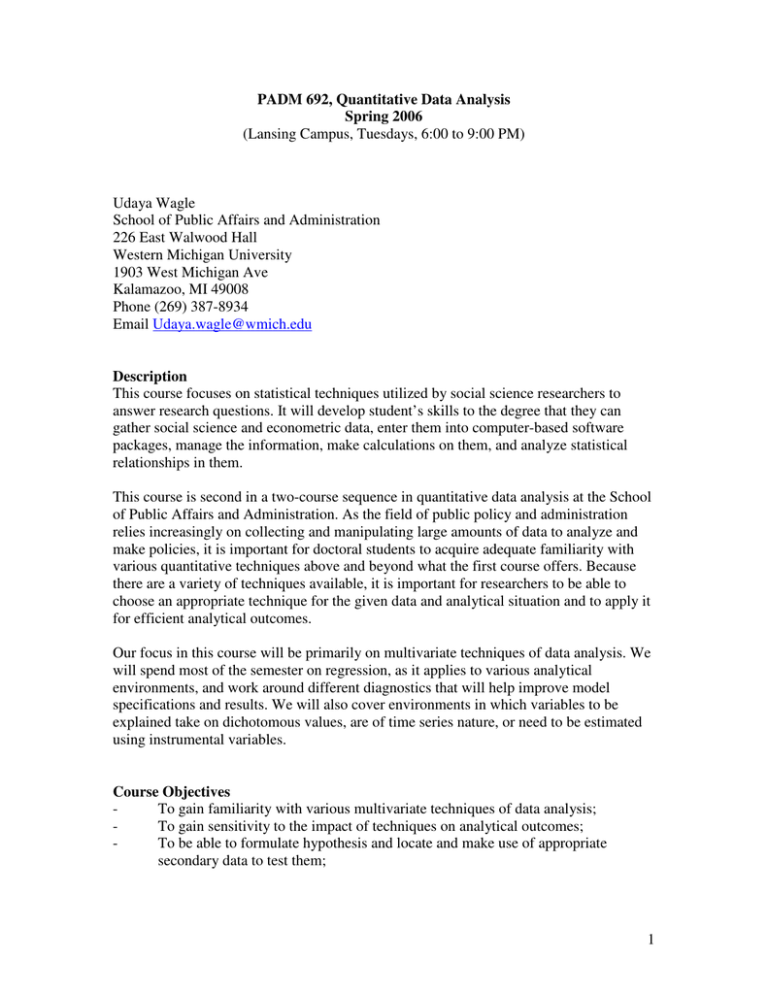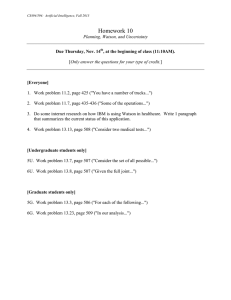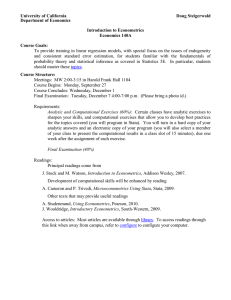(Lansing Campus, Tuesdays, 6:00 to 9:00 PM) Udaya Wagle
advertisement

PADM 692, Quantitative Data Analysis Spring 2006 (Lansing Campus, Tuesdays, 6:00 to 9:00 PM) Udaya Wagle School of Public Affairs and Administration 226 East Walwood Hall Western Michigan University 1903 West Michigan Ave Kalamazoo, MI 49008 Phone (269) 387-8934 Email Udaya.wagle@wmich.edu Description This course focuses on statistical techniques utilized by social science researchers to answer research questions. It will develop student’s skills to the degree that they can gather social science and econometric data, enter them into computer-based software packages, manage the information, make calculations on them, and analyze statistical relationships in them. This course is second in a two-course sequence in quantitative data analysis at the School of Public Affairs and Administration. As the field of public policy and administration relies increasingly on collecting and manipulating large amounts of data to analyze and make policies, it is important for doctoral students to acquire adequate familiarity with various quantitative techniques above and beyond what the first course offers. Because there are a variety of techniques available, it is important for researchers to be able to choose an appropriate technique for the given data and analytical situation and to apply it for efficient analytical outcomes. Our focus in this course will be primarily on multivariate techniques of data analysis. We will spend most of the semester on regression, as it applies to various analytical environments, and work around different diagnostics that will help improve model specifications and results. We will also cover environments in which variables to be explained take on dichotomous values, are of time series nature, or need to be estimated using instrumental variables. Course Objectives To gain familiarity with various multivariate techniques of data analysis; To gain sensitivity to the impact of techniques on analytical outcomes; To be able to formulate hypothesis and locate and make use of appropriate secondary data to test them; 1 - To be able to manipulate data and clearly, concisely, and consistently present them; To be able to use appropriate software for the needed statistical analyses; and To become critical consumers of reports and publications involving various multivariate techniques. Course Materials Following textbooks are required. Stock, James H. and Mark W. Watson. 2003. Introduction to Econometrics. New York: Addison-Wesley. (ISBN: 0-201-71595-3) Namboodiri, Krishnan. 1984. Matrix Algebra: An Introduction. Sage University Paper Series on quantitative Application in the Social Sciences, 07-038. Beverly Hills: Sage Publications. (ISBN: 0-8039-2052-0) Pampel, Fred C. 2000. Logistic Regression: A Primer. Sage University Paper Series on quantitative Application in the Social Sciences, 07-132. Beverly Hills: Sage Publications. (ISBN: 0-7619-2010-2) We will also use select chapters from the following supplemental books. I will provide you with a copy of the appropriate chapters but you will be responsible for making your own copies. Kennedy, Peter. 1998. A Guide to Econometrics (4th Edition). Cambridge: MIT Press. Studenmund, A.H. 2001. Using econometrics: A Practical Guide (4th Edition). New York: Addison-Wesley. Crown, William H. 1998. Statistical Models for the Social and Behavioral Sciences. Westport: Praeger. Delivery Method Classes will involve both traditional lecture presentation and lab demonstration. Since we are going to be continuing to use STATA, I expect you to supplement coursework with enough practice at home. While multivariate techniques that stand alone as statistical techniques do not necessarily have anything to do with any particular software, this course’s bias toward application focuses equally on “how to’s” of data analysis. Performance Evaluation There will be weekly problem sets (not every week though) to be completed either by hand or by using software. There is no exam in this course. But each student will be expected to carryout a project, in which you will conceive specific hypotheses, locate 2 appropriate secondary data, analyze data using (at least) one of the techniques introduced in the course, write a report, and present it in class. (I will provide a detailed description of this semester long assignment in a due course.) Finally, your active participation is also important. Following is the distribution of weights for each group of assignments. Weekly problem sets Research Project Presentation Participation Total 45% 35 10 10 100 I will use the following percent-letter (non)equivalencies as general guide to determine your grade. A ≥ 95 95>BA ≥ 90 90>B ≥ 85 85>CB ≥ 80 80>C ≥ 75 75>DC ≥ 70 70>D ≥ 65 D>E (Fail) Academic Honesty You are responsible for making yourself aware of and understanding the policies and procedures in the Graduate Catalog (pp. 25-27)] that pertain to Academic Honesty. These policies include cheating, fabrication, falsification and forgery, multiple submission, plagiarism, complicity and computer misuse. If there is reason to believe you have been involved in academic dishonesty, you will be referred to the Office of Student Conduct. You will be given the opportunity to review the charge(s). If you believe you are not responsible, you will have the opportunity for a hearing. You should consult with me if you are uncertain about an issue of academic honesty prior to the submission of an assignment or test. 3 Tentative weekly agenda 1. Basics of the course with Bivariate OLS Regression (1/10) Stock and Watson: Ch. 4 2. Matrix Algebra (1/17) Namboodiri: Chs. 1 and 2 3. Multiple Regression (1/24) Stock and Watson: Ch. 5 4. Specification and Diagnostics: Nonlinearity (1/31) Stock and Watson: Ch. 6 Crown: Ch. 4 Kennedy: Ch. 5 5. Diagnostics: Multicolinearity (2/7) Crown: Ch. 5, pp. 71-77 Studenmund: Ch. 8, pp. 243-72 6. Diagnostics: Heteroskedasticity, autocorrelation, and other specification issues (2/14) Stock and Watson: Ch. 7 Crown: Ch. 5, pp 77-97 Studenmund: Ch. 10, pp. 345-376 7. Regression with Panel Data (2/21) Stock and Watson: Ch. 8 8. Time Series Regression (3/7) Stock and Watson: Ch. 12 9. Logit and Probit (3/14) Stock and Watson: Ch. 9 Pampel: Chs. 1-5 10. IV Regression (3/21) Stock and Watson: Ch. 10 11. Experiments and Quasi-Experiments (3/28) Stock and Watson: Ch. 11 12. Presentation (4/4) 4



